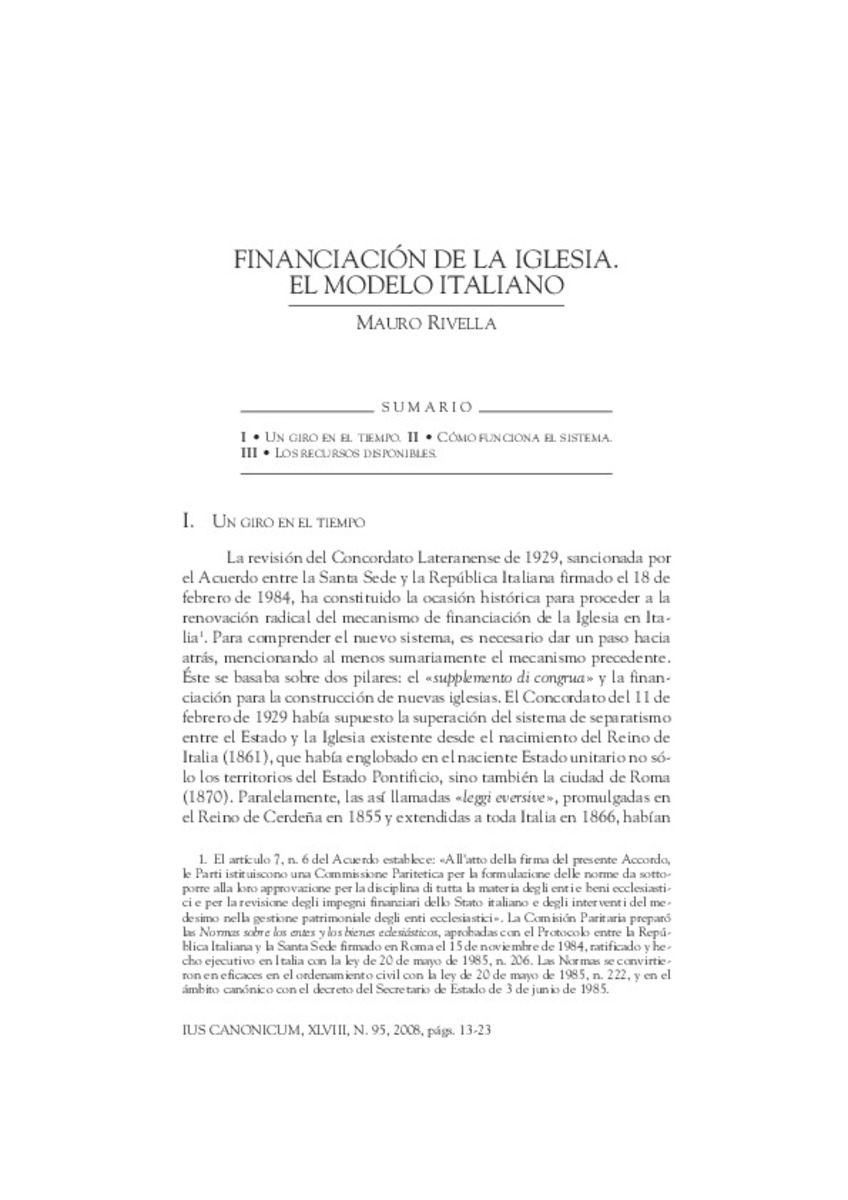Full metadata record
| DC Field | Value | Language |
|---|---|---|
| dc.creator | Rivella, M. (Mauro) | - |
| dc.date.accessioned | 2013-03-01T08:51:22Z | - |
| dc.date.available | 2013-03-01T08:51:22Z | - |
| dc.date.issued | 2008-06 | - |
| dc.identifier.citation | IUS CANONICUM, 2008, XLVIII, N. 95, págs. 13-23 | es_ES |
| dc.identifier.isbn | 0021-325X | - |
| dc.identifier.uri | https://hdl.handle.net/10171/28062 | - |
| dc.description.abstract | Después de la revisión de 1984 de los Pactos Lateranenses, se inauguró en Italia un sistema de financiación de la Iglesia que básicamente depende de que cada contribuyente determine anualmente el destino del ocho por mil del impuesto sobre la renta de las personas físicas. Se puede optar en favor de la Iglesia católica, el Estado u otras cinco confesiones religiosas que tienen Acuerdo suscrito con el Estado italiano. La parte correspondiente a los contribuyentes que no hayan expresado su elección, se distribuye siguiendo la misma proporción de los que sí la han expresado. Todo el dinero que la Iglesia reciba ha de ser destinado al culto, el sostenimiento del clero y las obras de caridad. Además es necesaria una rendición de cuentas anual. Junto a esta forma de financiación está previsto también un beneficio fiscal para las ofrendas libremente realizadas por los fieles para el sostenimiento del clero. Este sistema de financiación de la Iglesia, inaugurado a partir de 1984, garantiza a la Iglesia los medios para su normal funcionamiento. ------ After the revision in 1984 of the Lateran Pacts, the financing system of the Church, which basically depends upon each contributor who determines annually the destination of eight per thousand of the tax about the income of the physical persons was introduced in Italy. The contributor may choose in favor of the Catholic Church, the State or other five religious confessions which have an Agreement with the Italian State. The part corresponding to the contributors who have not expressed their choice is distributed following the same proportion with those who have expressed. All the money which the Church receives is to be used for divine worship, support of the clergy and works of charity. Besides, an annual financial report is necessary. Together with this form of financing, a fiscal benefit fot the offerings freely realized by Christ's faitful for the support of the clergy is also planned. This financing system which was introduced in 1984 assures the Church of the means for her normal operation. | es_ES |
| dc.language.iso | spa | es_ES |
| dc.publisher | Instituto Martín de Azpilcueta | es_ES |
| dc.rights | info:eu-repo/semantics/openAccess | es_ES |
| dc.subject | Materias Investigacion::Derecho canónico | es_ES |
| dc.title | Financiación de la Iglesia. El modelo italiano | es_ES |
| dc.type | info:eu-repo/semantics/article | es_ES |
| dc.type.driver | info:eu-repo/semantics/article | es_ES |
| dc.identifier.doi | 10.15581/016.48.14178 | es_ES |
Files in This Item:
Statistics and impact
Items in Dadun are protected by copyright, with all rights reserved, unless otherwise indicated.






